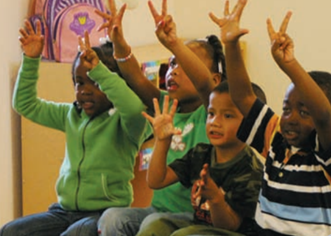9.1: Introduction
Mathematics is a natural part of the preschool environment. Young children actively construct mathematical knowledge through everyday interactions with their environment, whether inside or outside.

Mathematics learning grows naturally from children’s curiosity and enthusiasm to learn and explore their environment. During the preschool years, children continue to show a spontaneous interest in mathematics and further develop their mathematical knowledge and skills related to number, quantity, size, shape, and space. Teachers should encourage children’s natural enthusiasm and interest in doing mathematics and use it as a vehicle for supporting the development of children’s mathematical concepts and skills.
High-quality mathematics education in preschool is not about elementary arithmetic being pushed down onto younger children. It is broader than mere practice in counting and arithmetic. It is about children experiencing mathematics as they explore ideas of more and less, count objects, make comparisons, create patterns, sort and measure objects, and explore shapes in space. Mathematics learning happens throughout the day, and it is integrated with learning and developing in other developmental domains such as language and literacy, social-emotional, science, music, and movement. There is a general consensus “that high-quality, challenging and accessible mathematics education for three- to six-year-old children is a vital foundation for future mathematics learning.”
Teachers have a significant role in facilitating children’s construction of mathematical concepts. When teachers join children in becoming keen observers of their environment and in reasoning about numbers, shapes, and patterns, mathematics is enjoyable and exciting for all.

Teachers may not always realize the extent to which their current everyday classroom practices support children’s mathematical development. For example, when singing with children “Five Little Ducks Went Out One Day,” incorporating finger play with counting, the teacher develops children’s counting skills and understanding of numbers. Discussing with children how many children came to school today and how many are missing supports children’s arithmetic and reasoning with numbers. Playing with children in the sandbox by filling up different cups with sand and discussing which cup is the smallest or the largest or how many cups of sand it would take to fill up a bucket introduces children to concepts of comparison and measurement.[1]
- The California Preschool Curriculum Framework, Volume 1 by the California Department of Education is used with permission ↵

